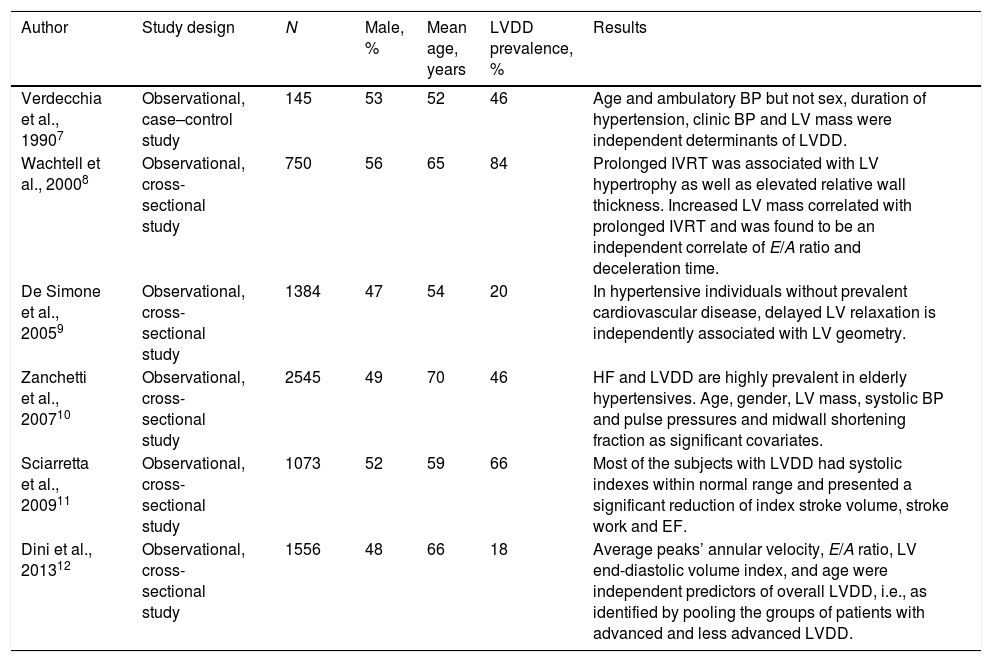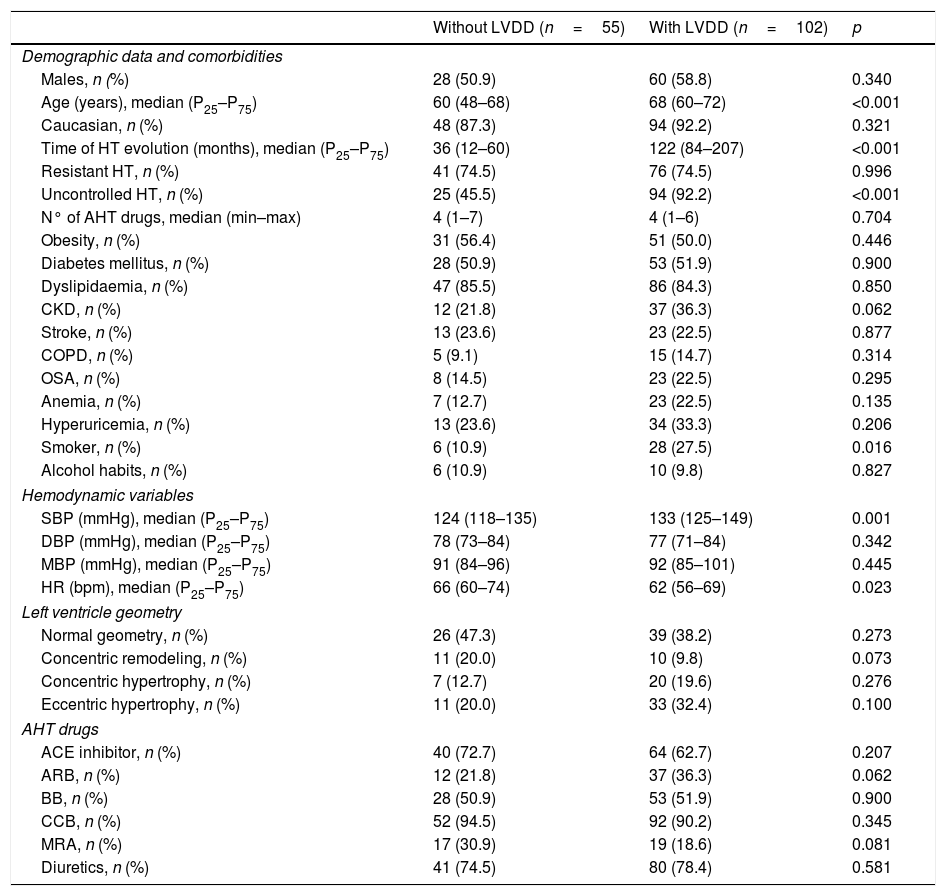The progression of hypertensive heart disease leads to the left ventricular diastolic dysfunction (LVDD), which is associated with increased cardiovascular morbidity and mortality. The purpose of this analysis is to explore the determinants for LVDD in patients with hypertension.
MethodsThis is a secondary analysis of data of Impedance Cardiography in the Evaluation of Left Ventricular Diastolic Dysfunction in Patients with Arterial Hypertension (IMPEDDANS) Study. Mann–Whitney and Chi-square tests were used for univariable analysis. Multiple logistic regression was used to model for LVDD occurrence and discriminative capacity of the model assessed by the value of the area under the curve given by the receiver-operating characteristic curve.
ResultsOlder age (65 vs. 58 years, p<0.001), longer duration of hypertension (160 vs. 48 months, p<0.001), uncontrolled hypertension (59.8 vs. 15.9%, p<0.001), tobacco smoking (17.8 vs. 3.8%, p=0.016), higher systolic blood pressure (133 vs. 124mmHg, p=0.001) and slower heart rate (62 vs. 66bpm, p=0.023) were associated with LVDD. Multivariate model identified uncontrolled hypertension (AdjOR 36.90; 95% CI 7.94–171.58; p<0.001), smoking (AdjOR 6.66; 95% CI 1.63–27.26; p=0.008), eccentric hypertrophy (AdjOR 3.59; 95% CI 0.89–14.39; p=0.072), duration of hypertension (AdjOR 1.03; 95% CI 1.02–1.05; p<0.001) and concentric remodeling (AdjOR 0.19; 95% CI 0.04–0.93; p=0.041) as the more determinant for occurrence of LVDD. The discriminative capacity of the model was AUC=0.95 (95% CI 0.91–0.98).
ConclusionThe occurrence of LVDD in hypertensive patients was strongly associated to long-lasting, uncontrolled hypertension, tobacco smoking, concentric remodeling and eccentric hypertrophy.
La progresión de la enfermedad cardiaca hipertensiva produce disfunción diastólica del ventrículo izquierdo (DDVI) y aumento de morbilidad y mortalidad. El objetivo de este estudio es evaluar los factores que se asocian a la DDVI en pacientes con hipertensión arterial.
MétodosSe trata de un análisis secundario del estudio IMPEDDANS. Se utilizaron las pruebas de la U de Mann-Whitney y la Chi-cuadrado para el análisis univariado, y posteriormente se realizó un análisis de regresión logística multivariado. La capacidad discriminativa del modelo fue evaluada por el valor del área bajo la curva (ABC) dada por la curva característica de funcionamiento del receptor.
ResultadosLos pacientes con DDVI eran mayores (65 vs. 58 años; p<0,001), tenían historia previa de hipertensión arterial más larga (160 vs. 48 meses; p<0,001), presentaban frecuentemente hipertensión arterial no controlada (59,8 vs. 15,9%; p<0,001), fumaban más (17,8 vs 3,8%; p=0,016), presentaban presión arterial sistólica más alta (133 vs. 124mmHg; p=0,001) y frecuencia cardiaca más lenta (62 vs. 66lpm; p=0,023). En el modelo multivariado se objetivó hipertensión no controlada (OR 36,90; IC 95% 7,94-171,58; p<0,001), hábito tabáquico (OR 6,66; IC 95% 1,63-27,26; p=0,008), hipertrofia excéntrica (OR 3,59; IC 95% 0,89-14,39; p=0,072), la duración de la hipertensión (OR 1,03; IC 95% 1,02-1,05; p<0,001) y remodelado concéntrico (OR 0,19; IC 95% 0,04-0,93; p=0,041) eran factores asociados a la DDVI. La capacidad discriminativa del modelo se correspondió con un ABC=0,95 (IC 95% 0,91-0,98).
ConclusiónEl desarrollo de la DDVI en pacientes con hipertensión arterial se asoció a la duración de la hipertensión, la hipertensión no controlada, el hábito tabáquico, el remodelado concéntrico y la hipertrofia excéntrica.
Artículo
Comprando el artículo el PDF del mismo podrá ser descargado
Precio 19,34 €
Comprar ahora











